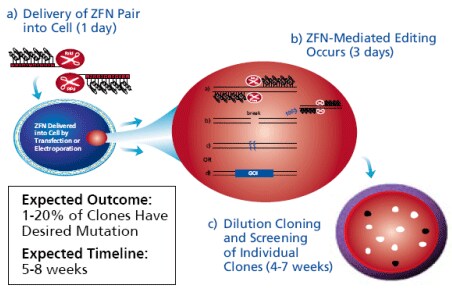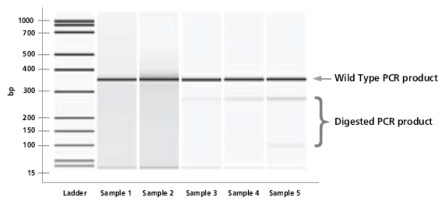How Do ZFNs Work?
Cell Line Engineering Made Simple
CompoZr™ ZFNs are used to create modified cell lines with targeted gene deletions, gene insertions, or gene corrections.
The CompoZr™ protocol for cell line modification starts with the delivery of a ZFN pair into a cell line of interest, and has been designed to be compatible with various standard methods of cellular delivery, including lipid-based transfection, electroporation and nucleofection™. Following delivery into the cell, ZFN-mediated editing will occur in as little as three days (Figure 1), at which point the clonal pool is ready to be assayed for rate-of-mutation.
Using ZFNs to Create Modified Cell Lines

Figure 1.Cell line modification using ZFNs is simple and relies on standard processes such as transfection, dilution cloning, and genotyping.
Gauging ZFN Efficiency
In the absence of an exogenous repair template, ZFN-induced double-strand breaks are typically repaired by a non-perfect cellular repair mechanism called Non-Homologous End Joining (NHEJ). Due to the imperfect fidelity of NHEJ, a minority of double-strand breaks within a ZFN-treated cellular population will be misrepaired, leading to cells in which either random heterogeneous genetic insertions or deletions have been made at the site of the double-stand break. We use a mismatch sensitive enzyme to look for these imperfect repairs, thereby quantifying the effectiveness of a ZFN pair.

Figure 2.A nucleotide mismatch assay is used to quantify the effectiveness of ZFNs. The mismatch assay consists of amplifying the target region from ZFN-treated genomic DNA via standard PCR. Resultant PCR products are denatured and allowed to re-anneal. A fraction of re-annealed products will contain bulges of DNA where heterogeneous mismatches occur. When a mismatch sensitive enzyme is added to the reaction, DNA digestion will occur at the site of the nucleotide mismatch. PCR pools are analyzed via PAGE. Sample pools 3–5 above contain cells that have been edited via ZFN-induced editing. The ratio of digested PCR products vs. wildtype PCR product is quantified by densitometry to determine rate of ZFN effectiveness.
如要继续阅读,请登录或创建帐户。
暂无帐户?